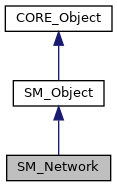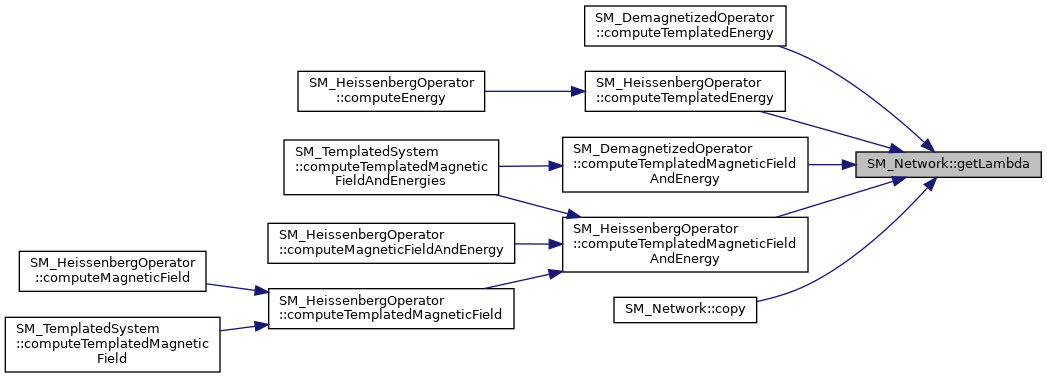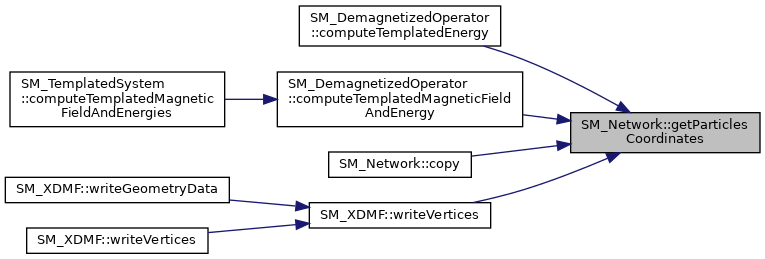This class is describes a a network. More...
#include <SM_Network.h>


Public Member Functions | |
| SM_Network (void) | |
| create a network class More... | |
| virtual | ~SM_Network (void) |
| destroy More... | |
| virtual tMemSize | getMemorySize () const |
| return the memory size of the class and the memory size of all its attributes/associations More... | |
| virtual tMemSize | getContentsMemorySize () const |
| return the memory size of the included associations More... | |
| void | copy (const SM_Network &network) |
| copy the network More... | |
| tDimension | getDimension () const |
| return the dimension More... | |
| void | setParticlesNumber (const tInteger &nParticles) |
| set the particles number More... | |
| tInteger | getParticlesNumber () const |
| return the particles number More... | |
| tIndex | computeAloneParticlesNumber () const |
| return the particles number More... | |
| void | setParticlesCoordinates (std::initializer_list< tReal > &&coords) |
| void set particles 3D-coordinates More... | |
| void | setParticlesCoordinates (const std::initializer_list< tReal > &coords) |
| void set particles 3D-coordinates More... | |
| void | setParticlesCoordinates (const SM_RealField &coords) |
| void set particles coordinates More... | |
| const SM_RealField & | getParticlesCoordinates () const |
| void get particles coordinates More... | |
| SM_RealField & | getParticlesCoordinates () |
| void get particles coordinates More... | |
| void | setLambda (const tReal &L) |
| set the lambda value More... | |
| const tReal & | getLambda () const |
| get the lambda value More... | |
| void | setNeighbors (std::valarray< tUInt > &&neighborsNumber, std::valarray< tIndex > &&neighborsIndices, std::valarray< tReal > &&Js) |
| set the neighbors by moving More... | |
| void | setNeighbors (const std::valarray< tUInt > &neighborsNumber, const std::vector< tIndex > &neighborsIndices, const std::vector< tReal > &Js) |
| set the neighbors by copy More... | |
| tIndex | getConnectionsNumber () const |
| get the number of connections More... | |
| const std::valarray< tUInt > & | getNeighborsNumber () const |
| get the neighbors number More... | |
| std::valarray< tUInt > & | getNeighborsNumber () |
| get the neighbors number More... | |
| const std::valarray< tIndex > & | getNeighborsIndices () const |
| std::valarray< tIndex > & | getNeighborsIndices () |
| const std::valarray< tReal > & | getHeissenbergCoefficients () const |
| get the Heissenberg coefficients More... | |
| std::valarray< tReal > & | getHeissenbergCoefficients () |
| get the Heissenberg coefficients More... | |
| void | create3DGrid (const tIndex &Nx, const tIndex Ny, const tIndex Nz, const tReal &Hx, const tReal &Hy, const tReal &Hz, const tReal &J, const tBoolean &hasSelfInteraction) |
| create a grid 3D of size Nx x Ny x Nz with distance between particles is hx x hy x hz the interaction between particles is modelized by J More... | |
| virtual tString | toString () const override |
| turn the class into a string representation More... | |
| template<class T > | |
| std::shared_ptr< T > | getSharedPointer () |
| return the shared pointer for this More... | |
| template<class T > | |
| std::shared_ptr< const T > | getConstSharedPointer () const |
| return a const shared pointer for this More... | |
| template<class T > | |
| tBoolean | isInstanceOf () const |
| test if the clas T is an instance of this class More... | |
| tString | getClassName () const |
| return the name of the class More... | |
| tString | getPointerString () const |
| retrun the pointer of the class as a string More... | |
| tString | getIdentityString () const |
| retrun the string identification of the class More... | |
Static Public Member Functions | |
| static CORE_UniquePointer< SM_Network > | New () |
| build a new instance of a Network More... | |
| static tBoolean | EnableMemoryStack (const tBoolean &isMemoryChecked) |
| enable the memory stack More... | |
| static void | EnableMemoryStack () |
| enable the memory stack More... | |
| static void | DisableMemoryStack () |
| disable the memory stack More... | |
| static tBoolean | IsMemoryStackEnabled () |
| return trur if the memory stack is enabled More... | |
| static tString | MemoryStackToString () |
| get the memory stack in string More... | |
| static tIndex | GetRegisteredClassesNumber () |
| get the memory stack in string More... | |
Private Member Functions | |
| template<class T > | |
| std::shared_ptr< T > | setThis (std::unique_ptr< T, CORE_Object::Delete > &up) |
| set the shared pointer from an unique pointer More... | |
Private Attributes | |
| tReal | mLambda |
| SM_RealField | mPoints |
| std::valarray< tUInt > | mNeighborsNumber |
| std::valarray< tIndex > | mNeighborsIndices |
| std::valarray< tReal > | mJs |
| std::weak_ptr< CORE_Object > | mThis |
Detailed Description
This class is describes a a network.
- Version
- 2.0
Constructor & Destructor Documentation
◆ SM_Network()
|
inline |
create a network class
References mLambda, mNeighborsNumber, mPoints, and CORE_Field< T, K, D, S, I >::setElementsNumber().
Referenced by New().


◆ ~SM_Network()
|
inlinevirtual |
destroy
Member Function Documentation
◆ computeAloneParticlesNumber()
|
inline |
return the particles number
- Returns
- the number of particles without any connections
References mNeighborsNumber, and tIndex.
Referenced by SM_XDMF::writeGeometryHeader().

◆ copy()
|
inline |
copy the network
- Parameters
-
[in] network : the network to copy
References CORE_Field< T, K, D, S, I >::copy(), getHeissenbergCoefficients(), getLambda(), getNeighborsIndices(), getNeighborsNumber(), getParticlesCoordinates(), mJs, mLambda, mNeighborsIndices, mNeighborsNumber, and mPoints.

◆ create3DGrid()
| void SM_Network::create3DGrid | ( | const tIndex & | Nx, |
| const tIndex | Ny, | ||
| const tIndex | Nz, | ||
| const tReal & | Hx, | ||
| const tReal & | Hy, | ||
| const tReal & | Hz, | ||
| const tReal & | J, | ||
| const tBoolean & | hasSelfInteraction | ||
| ) |
create a grid 3D of size Nx x Ny x Nz with distance between particles is hx x hy x hz the interaction between particles is modelized by J
- Parameters
-
[in] Nx number of particles in the x-direction [in] Ny number of particles in the y-direction [in] Nz number of particles in the z-direction [in] Hx distance between 2 particles in the x-direction [in] Hy distance between 2 particles in the y-direction [in] Hz distance between 2 particles in the z-direction [in] J interaction factor of 2 particles [in] hasSelfInteraction : true to make an interaction between each particle and itself
References CORE_Field< T, K, D, S, I >::getValues(), mPoints, CORE_Field< T, K, D, S, I >::setElementsNumber(), setNeighbors(), tIndex, tReal, tRelativeIndex, tSInt, tUInt, and tUSInt.
Referenced by SM_Test::grid3DParticlesTestCase(), SM_Test::linedParticlesTestCase(), SM_Run::loadNetworkFromOptions(), SM_Test::testEnergyOperatorsDerivatives(), and SM_Test::testVirtualMethods().


◆ DisableMemoryStack()
|
inlinestaticinherited |
disable the memory stack
Referenced by CORE_Object::EnableMemoryStack().

◆ EnableMemoryStack() [1/2]
|
inlinestaticinherited |
enable the memory stack
Referenced by CORE_Object::EnableMemoryStack(), and CORE_Run::SetDebugOptions().

◆ EnableMemoryStack() [2/2]
|
inlinestaticinherited |
enable the memory stack
- Parameters
-
[in] isMemoryChecked : true to verify memory allocation of CORE_Object classes
- Returns
- true if the memroy is checked
References CORE_Object::DisableMemoryStack(), CORE_Object::EnableMemoryStack(), and CORE_Object::IsMemoryStackEnabled().

◆ getClassName()
|
inlineinherited |
return the name of the class
- Returns
- the string name of the class
Referenced by CORE_Object::getIdentityString(), and CORE_Test::testTypes().

◆ getConnectionsNumber()
|
inline |
get the number of connections
- Returns
- the number of connections
References mNeighborsIndices.
Referenced by SM_XDMF::writeGeometryHeader().

◆ getConstSharedPointer()
|
inlineinherited |
return a const shared pointer for this
- Returns
- the shared pointer as a type T
References CORE_Object::mThis.
◆ getContentsMemorySize()
|
inlinevirtual |
return the memory size of the included associations
- Returns
- the memory size of the storage in bytes 1 Kb = 1024 bytes 1 Mb = 1024 Kb 1 Gb = 1024 Mb 1 Tb = 1024 Gb 1 Hb = 1024 Tb
Reimplemented from CORE_Object.
References CORE_Object::getContentsMemorySize(), CORE_Field< T, K, D, S, I >::getContentsMemorySize(), mJs, mNeighborsIndices, mNeighborsNumber, mPoints, tIndex, tMemSize, tReal, and tUInt.
Referenced by SM_System::getContentsMemorySize(), and getMemorySize().


◆ getDimension()
|
inline |
return the dimension
References CORE_Field< T, K, D, S, I >::getDimension(), and mPoints.
Referenced by SM_Operator::computeEnergy(), SM_ZeemanOperator::computeEnergy(), SM_Beam::computeL2Convergence(), SM_System::computeMagneticField(), SM_System::computeMagneticFieldAndEnergies(), SM_DemagnetizedOperator::computeTemplatedEnergy(), SM_HeissenbergOperator::computeTemplatedEnergy(), SM_ZeemanOperator::computeTemplatedEnergy(), SM_TemplatedSystem< SystemImpl >::computeTemplatedMagneticField(), SM_TemplatedSystem< SystemImpl >::computeTemplatedMagneticFieldAndEnergies(), SM_DemagnetizedOperator::computeTemplatedMagneticFieldAndEnergy(), SM_ZeemanOperator::computeTemplatedMagneticFieldAndEnergy(), SM_HeissenbergOperator::computeTemplatedMagneticFieldAndEnergy(), SM_Beam::discretize(), SM_Output::generateOutput(), SM_Test::grid3DParticlesTestCase(), SM_Run::loadMagneticMomentFromOptions(), SM_System::makeRelaxation(), SM_TemplatedSystem< SystemImpl >::makeTemplatedRelaxation(), SM_VTK::save(), SM_Test::testEnergyOperatorsDerivatives(), toString(), SM_System::toString(), SM_Test::validate(), and SM_XDMF::writeContentData().


◆ getHeissenbergCoefficients() [1/2]
|
inline |
get the Heissenberg coefficients
- Returns
- Js as heissenberg coefficient for each link between 2 particles of size mNeighborsIndices.sum()
References mJs.
◆ getHeissenbergCoefficients() [2/2]
|
inline |
get the Heissenberg coefficients
- Returns
- Js as heissenberg coefficient for each link between 2 particles of size mNeighborsIndices.sum()
References mJs.
Referenced by SM_HeissenbergOperator::computeTemplatedEnergy(), SM_HeissenbergOperator::computeTemplatedMagneticFieldAndEnergy(), and copy().

◆ getIdentityString()
|
inlineinherited |
retrun the string identification of the class
- Returns
- the string identity of the class
References CORE_Object::getClassName(), and core_functions::pointerToString().
Referenced by CORE_Test::testArray(), CORE_Test::testField(), CORE_Test::testTypes(), CORE_Object::toString(), CORE_ClassFactory::toString(), and CORE_Field< T, K, D, S, I >::toString().


◆ getLambda()
|
inline |
get the lambda value
- Returns
- the lambda value
References mLambda.
Referenced by SM_DemagnetizedOperator::computeTemplatedEnergy(), SM_HeissenbergOperator::computeTemplatedEnergy(), SM_DemagnetizedOperator::computeTemplatedMagneticFieldAndEnergy(), SM_HeissenbergOperator::computeTemplatedMagneticFieldAndEnergy(), and copy().

◆ getMemorySize()
|
inlinevirtual |
return the memory size of the class and the memory size of all its attributes/associations
- Returns
- the memory size of the class and the memory size of its attributes/associations in bytes The mamory size is :
- the added size of the base classes which contains:
- the primary attributes size depends on the order: (first delare the smallest attributes size
- all virtual functions costs <pointer-size> (4 32xor 8 64x) bytes by virtual function
- virtual inherihtance will increase of (4 or 8) bytes
- we add the size of the contains values of the attributes : for example the size of a string is the length of the string 1 octet = 1 byte 1 Ko = 1024 bytes 1 Mo = 1024 Ko 1 Go = 1024 Mo
- the added size of the base classes which contains:
Reimplemented from SM_Object.
References getContentsMemorySize().

◆ getNeighborsIndices() [1/2]
|
inline |
References mNeighborsIndices.
◆ getNeighborsIndices() [2/2]
|
inline |
References mNeighborsIndices.
Referenced by SM_HeissenbergOperator::computeTemplatedEnergy(), SM_HeissenbergOperator::computeTemplatedMagneticFieldAndEnergy(), copy(), and SM_XDMF::writeGeometryHeader().

◆ getNeighborsNumber() [1/2]
|
inline |
get the neighbors number
- Returns
- the neighborsNumber as number of neighbors for each particle of size mParticlesNumber
References mNeighborsNumber.
◆ getNeighborsNumber() [2/2]
|
inline |
get the neighbors number
- Returns
- the neighborsNumber as number of neighbors for each particle of size mParticlesNumber
References mNeighborsNumber.
Referenced by SM_HeissenbergOperator::computeTemplatedEnergy(), SM_HeissenbergOperator::computeTemplatedMagneticFieldAndEnergy(), copy(), and SM_XDMF::writeGeometryHeader().

◆ getParticlesCoordinates() [1/2]
|
inline |
◆ getParticlesCoordinates() [2/2]
|
inline |
void get particles coordinates
- Returns
- coordinates of the particles
References mPoints.
Referenced by SM_DemagnetizedOperator::computeTemplatedEnergy(), SM_DemagnetizedOperator::computeTemplatedMagneticFieldAndEnergy(), copy(), and SM_XDMF::writeVertices().

◆ getParticlesNumber()
|
inline |
return the particles number
- Returns
- the number of particles
References CORE_Field< T, K, D, S, I >::getElementsNumber(), and mPoints.
Referenced by SM_Operator::computeEnergy(), SM_ZeemanOperator::computeEnergy(), SM_Beam::computeL2Convergence(), SM_System::computeMagneticField(), SM_System::computeMagneticFieldAndEnergies(), SM_DemagnetizedOperator::computeTemplatedEnergy(), SM_HeissenbergOperator::computeTemplatedEnergy(), SM_ZeemanOperator::computeTemplatedEnergy(), SM_TemplatedSystem< SystemImpl >::computeTemplatedMagneticField(), SM_TemplatedSystem< SystemImpl >::computeTemplatedMagneticFieldAndEnergies(), SM_DemagnetizedOperator::computeTemplatedMagneticFieldAndEnergy(), SM_ZeemanOperator::computeTemplatedMagneticFieldAndEnergy(), SM_HeissenbergOperator::computeTemplatedMagneticFieldAndEnergy(), SM_Beam::discretize(), SM_System::discretize(), SM_PermanentZeemanOperator::discretize(), SM_ZeemanOperator::discretize(), SM_Output::generateOutput(), SM_Test::grid3DParticlesTestCase(), SM_Run::loadMagneticMomentFromOptions(), SM_System::makeRelaxation(), SM_TemplatedSystem< SystemImpl >::makeTemplatedRelaxation(), SM_VTK::save(), SM_Test::testEnergyOperatorsDerivatives(), toString(), SM_Test::validate(), and SM_XDMF::writeContentData().


◆ getPointerString()
|
inlineinherited |
retrun the pointer of the class as a string
- Returns
- the pointer of the calss as a string
References core_functions::pointerToString().

◆ GetRegisteredClassesNumber()
|
inlinestaticinherited |
get the memory stack in string
- Returns
- the string representation of the memory stack
◆ getSharedPointer()
|
inlineinherited |
return the shared pointer for this
- Returns
- the shared pointer as a type T
References CORE_Object::mThis.
◆ isInstanceOf()
|
inlineinherited |
test if the clas T is an instance of this class
- Returns
- true if the object is an instance of T
Referenced by SM_Beam::templatedSimulate().

◆ IsMemoryStackEnabled()
|
inlinestaticinherited |
return trur if the memory stack is enabled
Referenced by CORE_Object::EnableMemoryStack(), and main().

◆ MemoryStackToString()
|
inlinestaticinherited |
get the memory stack in string
- Returns
- the string representation of the memory stack
Referenced by main().

◆ New()
|
inlinestatic |
build a new instance of a Network
- Returns
- an unique pointer of Network
References SM_Network().
Referenced by SM_Run::createMagneticDipolarMap(), and SM_ClassFactory::NewInstance().


◆ setLambda()
|
inline |
◆ setNeighbors() [1/2]
|
inline |
set the neighbors by copy
- Parameters
-
[in] neighborsNumber number of neighbors for each particle of size mParticlesNumber [in] neighborsIndices indices of neighbors for each particle of size mParticlesNumber x sum of neighborsNumber[i] [in] Js heissenberg coefficient for each link between 2 particles
References mJs, mNeighborsIndices, mNeighborsNumber, tIndex, and tReal.
◆ setNeighbors() [2/2]
|
inline |
set the neighbors by moving
- Parameters
-
[in] neighborsNumber number of neighbors for each particle of size mParticlesNumber [in] neighborsIndices indices of neighbors for each particle of size mParticlesNumber x sum of neighborsNumber[i] [in] Js heissenberg coefficient for each link between 2 particles
References mJs, mNeighborsIndices, and mNeighborsNumber.
Referenced by create3DGrid().

◆ setParticlesCoordinates() [1/3]
|
inline |
void set particles coordinates
- Parameters
-
[in] coords : coordinates of the particles
References mPoints.
◆ setParticlesCoordinates() [2/3]
|
inline |
◆ setParticlesCoordinates() [3/3]
|
inline |
◆ setParticlesNumber()
|
inline |
set the particles number
- Parameters
-
[in] nParticles : number of particles
References mPoints, and CORE_Field< T, K, D, S, I >::setElementsNumber().

◆ setThis()
|
inlineprivateinherited |
set the shared pointer from an unique pointer
- Parameters
-
[in,out] up unique pointer of the class at input, points to null pointer at output
- Returns
- the shared pointer of the class
Method only calledby the friend class CORE_ClassFactory::NewSharedInstance()
References CORE_Object::mThis.
◆ toString()
|
overridevirtual |
turn the class into a string representation
- Returns
- a string representation of the class
Reimplemented from CORE_Object.
References CORE_Field< T, K, D, S, I >::getDimension(), getDimension(), CORE_Field< T, K, D, S, I >::getElementsNumber(), getParticlesNumber(), mJs, mLambda, mNeighborsIndices, mNeighborsNumber, mPoints, tIndex, CORE_Object::toString(), tReal, and tUInt.
Referenced by SM_System::toString().


Member Data Documentation
◆ mJs
|
private |
Referenced by copy(), getContentsMemorySize(), getHeissenbergCoefficients(), setNeighbors(), and toString().
◆ mLambda
|
private |
Referenced by copy(), getLambda(), setLambda(), SM_Network(), and toString().
◆ mNeighborsIndices
|
private |
Referenced by copy(), getConnectionsNumber(), getContentsMemorySize(), getNeighborsIndices(), setNeighbors(), and toString().
◆ mNeighborsNumber
|
private |
Referenced by computeAloneParticlesNumber(), copy(), getContentsMemorySize(), getNeighborsNumber(), setNeighbors(), SM_Network(), and toString().
◆ mPoints
|
private |
◆ mThis
|
privateinherited |
Referenced by CORE_Object::getConstSharedPointer(), CORE_Object::getSharedPointer(), and CORE_Object::setThis().
The documentation for this class was generated from the following files: